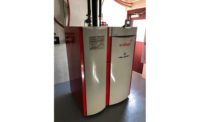Nearly all space heating systems that include renewable energy heat sources have a thermal storage tank. In most of these systems, the volume of that tank is substantial.
Here are some typical thermal storage guidelines for such systems:
• Solar thermal systems: 1.5 to 2.5 gal. per sq.-ft. of collector area;
• Wood gasification boilers: 100-130 gal. of water storage per cu-ft. of primary combustion chamber volume; and
• Pellet-fired boilers: 1 to 2 gal. of thermal storage per 1,000 Btu/hr. of rated boiler capacity.
When applied to residential and light commercial space heating systems, these guidelines result in storage requirements of 100 to 1,000 gal. Such large storage vessels can hold hundreds of thousands of useful Btu. It makes sense to extract as much of this energy as possible before invoking an auxiliary energy source to cover any portion of the load beyond what can be supplied by the renewable energy source. The lower the temperature to which the thermal storage tank can be lowered, while still supplying useful heat to the load, the better this can be accomplished.
Figure 1 illustrates how the useful heat extracted from thermal storage can be enhanced by using an outdoor reset controller to turn on the auxiliary heat source when necessary. This topic was discussed in more detail in my June 2015 pme column.
This scenario assumes the thermal storage tank starts with an average water temperature of 150° F. This average temperature is based on 160° water at the top of the tank and 140° water at the bottom.
At design load conditions, the heating distribution system represented by this graph requires a target supply water temperature of 120° The outdoor reset controller monitoring the temperature in the upper portion of the storage tank has its differential set 5°.
Thus, based on supply temperature, this tank can contribute heat to the design space heating load until the temperature at the top of the tank drops to one half the differential below the target temperature (e.g., 120-5/2) = 117.5°. At that temperature the outdoor reset controller turns on the auxiliary heat source.
However, at an outdoor temperature of 40°, the target supply water temperature required by the distribution system is much lower. Heat can be delivered from storage to the distribution system until the temperature in the upper portion of the tank drops to about 88°.
This demonstrates the advantage of using an outdoor reset controller to determine whether heat is supplied from storage or by the auxiliary heat source. It also demonstrates the advantage of designing distribution systems supplied through thermal storage tanks for low supply water temperatures.
Considering the performance characteristics of mod/con boilers, as well as those of currently available renewable energy heat sources, I propose that all hydronic heating distribution systems should be capable of supplying design load using a supply water temperature no higher than 120°. Even lower design load supply water temperatures are preferred when possible.
In return
The scenario just described for turning on the auxiliary heat source was solely based on measurement of supply water temperature. Furthermore, this scenario limits heat input to the distribution system to either the thermal storage tank or the auxiliary heat source. It never allows both to operate at the same time, even if such operation could provide beneficial results.
Figure 2 shows a space-heating system supplied from a thermal storage tank, and when necessary, an auxiliary boiler.
Consider a situation where the temperature in the upper portion of the tank at sensor (T1) is slightly lower than the lower limit established by the outdoor reset controller, but still warmer than the return temperature of the distribution system. Under these conditions the tank could still contribute useful heat to the space heating load. The required supplemental heat would come from the auxiliary boiler.
Based on this observation, the control objective changes to: Extract heat from the thermal storage tank as long as the temperature leaving the upper portion of the tank remains above the return temperature from the distribution system.
This can be done by adding a differential temperature controller to the system as shown in Figure 3.
The differential temperature controller (DTC) measures the temperature difference between sensor (T3) in the upper portion of the tank and sensor (T2) at the return side of the distribution system. As long as the temperature at (T3) is warmer than the temperature at sensor (T2), the tank can contribute heat to the load, with the remainder added by the auxiliary (modulating) boiler.
Figure 4shows a ladder diagram that contains the operating logic for a system piped as shown in Figure 3 and controlled based on this concept.
If the outdoor reset controller (ORC) determines that the tank is too cool to supply the space heating load, its normally open contact closes to power up the differential temperature controller (DTC) as well as a relay (R1) that enables the boiler to operate.
The differential temperature controller (DTC) measures the temperature difference between water at the top of the storage tank at sensor (T3) and the temperature of water returning from the distribution system at sensor (T2). If the top of tank temperature (T3) is at least 4° above the distribution return temperature (T2), the normally open contact in the differential temperature controller (DTC) closes. This energizes the coil of relay (R4). The normally open contact (R4-1) releases, which turns off the diverter valve (DV1). This allows flow returning from the distribution system to continue flowing through the thermal storage tank (e.g., from the AB port of the diverting valve to its B port).
The boiler and its circulator (P1) also are operating at this time. The boiler is monitoring the temperature downstream of the closely spaced tees. Ideally it modulates to add just enough heat to maintain this temperature close to the target temperature required by the distribution system based on the settings of the boiler’s internal controller. The higher the turndown ratio of the boiler, the better it can accomplish this.
The mixing valve (MV1), operating under its own outdoor reset control logic, and with the same settings as the boiler’s internal reset controller, should be at or very close to its fully open position. As such very little if any mixing occurs.
When the temperature difference between the top of the storage tank and the return side of the distribution system drops to 2° or less, there is very little useful heat remaining in the thermal storage tank. Under this condition the differential temperature controller turns off relay (R4). The normally closed contact (R4-1) closes allowing 24 VAC to energize diverter valve (DV1).
This stops flow returning from the distribution system from passing into the thermal storage tank. Instead, that flow is routed out the (A) port of the diverting valve (DV1). The auxiliary boiler and circulator (P1) remains on to supply the space heating load as required.
When the storage tank temperature again rises to where the temperature differential between the top of the tank and the return side of the distribution system reaches 4° or more and there is a demand for space heating, the diverter valve is turned off. The returning flow from the distribution system again is allowed to pass through the thermal storage tank to absorb any available heat.
Use where appropriate
This strategy makes sense when a large storage tank is used in the system. I suggest that it’s appropriate when the storage tank volume is at least 500 gal. The ability to lower 500 gal. of water by an additional 10° implies a release of almost 42,000 additional Btu from the tank. Smaller tanks would contribute proportionally smaller amounts of heat and provide less justification for the additional controls.
When implementing this strategy it’s very important that the temperature sensors for the differential temperature controller are identical in their temperature vs. resistance characteristic curves. It also is important that both sensors are mounted in an identical manner. Ideally, both sensors should be mounted in identical sensor wells, immersed in the system water, and with ample coatings of thermal grease.
If mounted to the surface of copper tubing, be sure the sensor surface makes good contact, is well-secured and is fully wrapped with insulation. Remember, this strategy requires the differential temperature controller to detect temperature differences as low as 2°. Such low temperature differences are difficult for most people to detect with their bare fingers.
Figure 5shows how this additional heat extraction strategy, using a differential temperature controller in combination with the reset controller, increases the useful heat available from storage.
The additional heat extraction potential is greatest at design load conditions and decreases as the temperature drop of the distribution system decreases.
The use of the differential temperature controller, in combination with the piping shown, also prevents heat generated by the auxiliary boiler from inadvertently heating the thermal storage tank.
This control strategy can be implemented using readily available outdoor reset controllers and a differential temperature controller. If available, it also could be programmed into a building automation system. When used, the described operation of the controls should be carefully verified when the system is commissioned and tested on an annual basis.
This strategy “squeezes” the “Btu sponge” (e.g., the thermal storage tank) to its lowest useable temperature before shifting the load solely to auxiliary heat. This minimizes the water temperature supplied from thermal storage to the renewable energy heat source.
Solar thermal collectors and heat pumps will operate with higher efficiency and thus harvest more renewable energy. When used with a biomass boiler, the reward will be longer and fewer boiler operating cycles. This also improves thermal efficiency and reduces emissions.
This article was originally titled “Squeezing the sponge” in the October 2015 print edition of PM Engineer.







